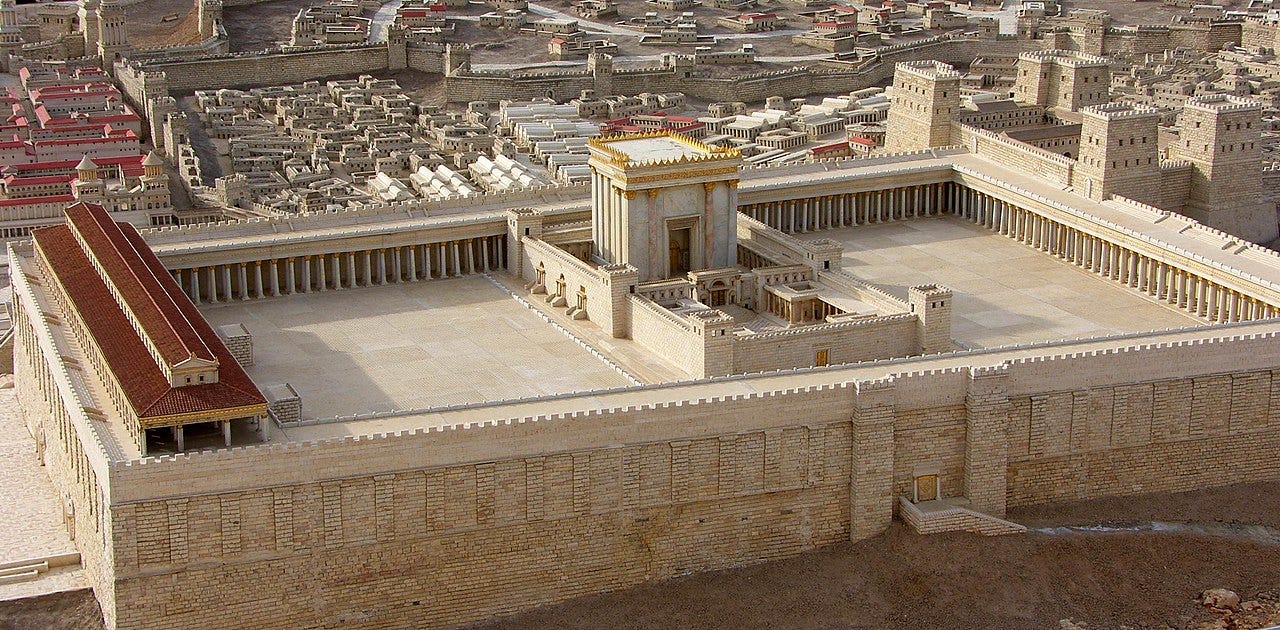Was there more than one Temple of YHWH?
Old Testament / History / Mythology
When we speak of the Temple of YHWH, the first thing that comes to mind is Solomon’s Temple in Jerusalem. This is what we read in the Hebrew Bible. It was THE place of worship for their cult deity and it was centered in Jerusalem. However, when sifting through the archaeological evidence, it immediately becomes apparennt that this was not always the case. In fact, throughout the ancient world, many cults of YHWH with their own temples have been built, ranging from the Levant all the way to Egypt.
To start off with Egypt, there was a temple to YHWH located in Elephantine, and YHWH was also worshiped alongside other deities: [1]
Labeled: Padua 1 (Museo Civico di Padova) ca. 475-450 BCE
שלם בית יהו ביב
Greetings to the temple of YHW in Elephantine! [2]
Labeled: O. Clermont-Ganneau 70 ca. 475 BCE
לך ברכתך ליהה ולחנב
I bless you by YHH and Khnum. [3]
We also read of a Queen of Heaven: [4]
Labeled: Hermopolis 4 ca. 6th-5th century BCE
שלם בית בתאל ובית מלכת סמין
Greetings to the temple of Bethel and the temple of the Queen of Heaven.
The very same Queen of Heaven we find in the Book of Jeremiah. [5] It is generally believed that this Queen of Heaven is the Canaanite Asherah or Astarte, and may have played as a consort to YHWH. Note that I will be speaking to the topic of God having a wife in a future post.
Also confirmed in the Samaritan Pentateuch [6], we have a YHWH of Samaria with His own place of worship:[7]
Labeled: Kuntillet `Ajrûd Pithos A ca. 9th-8th century BCE
ברכת אתכם ליהוה שמרן ולאשרתה
I bless you by YHWH of Samaria and his Asherah.
Labeled: Kuntillet `Ajrûd Pithos B ca. 9th-8th century BCE
ברכתך ליהוה תמן ולאשרתה
I bless you by YHWH of Teman and his Asherah.
It is still unknown as to where Teman is truly located. Scholars have assumed that this is the Edomite Teman mentioned in Jeremiah 49:7, 20; Ezekiel 25:13; Amos 1:13; and Obadiah 9. In fact, the Samaritan Pentateuch holds an additional commandment, which states that YHWH can only be worshiped at Mt. Gerizim, in the West Bank, and not at His temple in Jerusalem.
What I find most interesting of all materials relating to this topic is a reference to a temple in Jerusalem, existing prior to the date believed to be the construction of Solomon’s Temple. These references come from the El Amarna letters, correspondences between the Egyptian Pharaoh and various Canaanites discussing certain matters ranging from tribute to warfare. EA 290 reads [8]:
They have hired soldiers of Gazri [Gezer], soldiers of Gimti [Gath], and soldiers of Kilti [Keilah or Ekron?], they have conquered the land of the city of Rubute. The land of the king has fallen away to the Habiru; and now in additon to that a city of the land of Jerusalem, whose name is Bit-Ninib, a city of the king, has gone forth were the people of Kilti are. This (will be) the fate of the la[nd]. [L]et him [smi]te (?) the son of Milki[lu], [and l]et him sm[it]e (?) the so[n of Suardat]u ....Ginti, a[n]d let the king care for [his] land.
Dating to the 14th century BCE, we read of Jerusalem holding a temple to the god Ninib (a.k.a. Ninurta, the Mesopotamian storm god of fertility). [9] There are two things that should strike the reader as odd and contradictory with the biblical texts. First things first, prior to the conquest of the Promised Land and taking over Jebus, the city-state within Judah was supposedly not known as Jerusalem. The name change occurred after the conquest of Jebus. This inscription predates the Israelite Conquest and calls out Jerusalem (actually Urusalim) as a major city of influence and power in the Levant. More references to Jerusalem in the Amarna letters can be found in EA 285-290. The second odd item is that a Temple to Ninurta exists within the city, and not a Temple to YHWH (Solomon’s Temple). Did the Temple of Ninurta mark the location of what was later to become the Temple of YHWH? If so, then how did a construction take place under the direction of Solomon? Or was it more of a remodeling?
Featured image: Herod's Temple as imagined in the Holyland Model of Jerusalem. (Public Domain)
Notes
[1] Lindenberger, James M. Ancient Aramaic and Hebrew Letters. Atlanta: Society of Biblical Literature, 2003. 36-37, 49.
[2] Yeb was the ancient name Elephantine.
[3] Khnum was an ancient creator deity of Egypt. In the Hebrew text cited it is spelled Khnub. This should come as no surprise as names tend to get corrupted throughout time.
[4] Lindenberger, James M. Ancient Aramaic and Hebrew Letters. Atlanta: Society of Biblical Literature, 2003. 32.
[5] Reference Jer. 7:18; 44:17-25.
[6] The Samaritan Pentateuch is the text of the Torah written in the Samaritan script and used by the Samaritans. It dates to the Second Temple period and is believed to be no older than the mid-5th century BCE.
[7] Lindenberger, James M. Ancient Aramaic and Hebrew Letters. Atlanta: Society of Biblical Literature, 2003. 136.
[8] The cuneiform tablets discovered at Tell el-Amarna in Egypt are known as the Amarna Letters, and the "EA" designation stands for "El-Amarna".
[9] Bit-Ninip (Temple of Ninurta) is mentioned again in EA 74.



